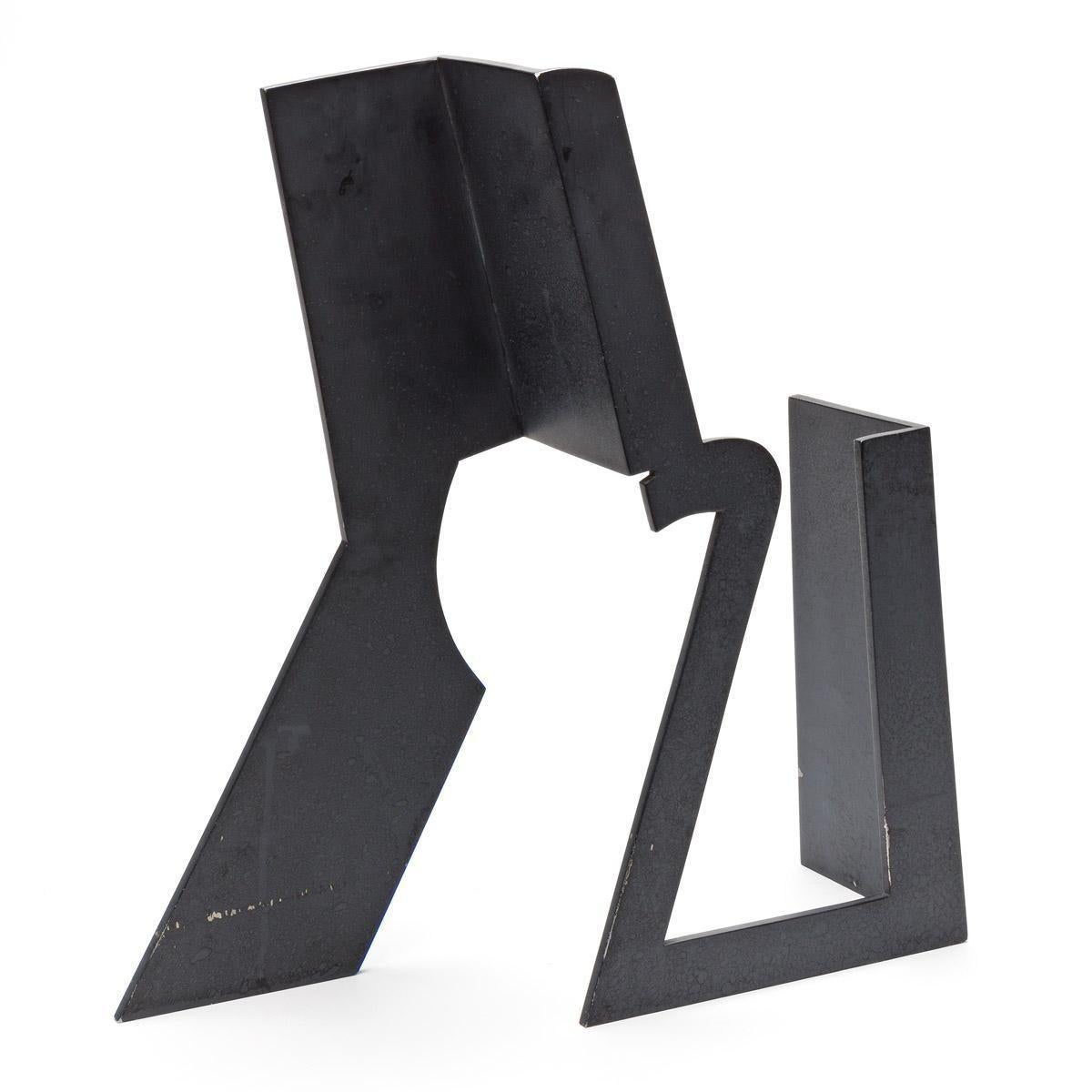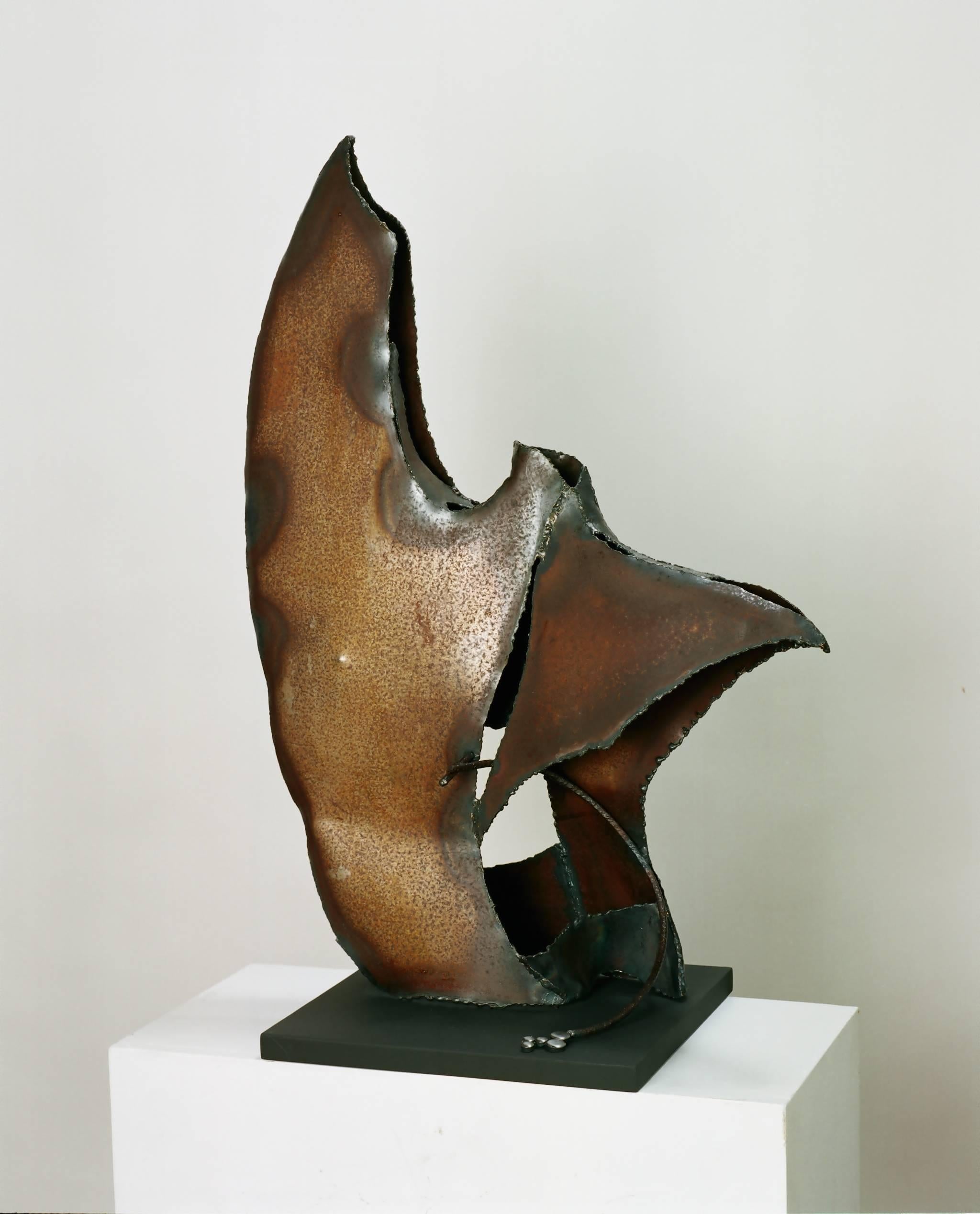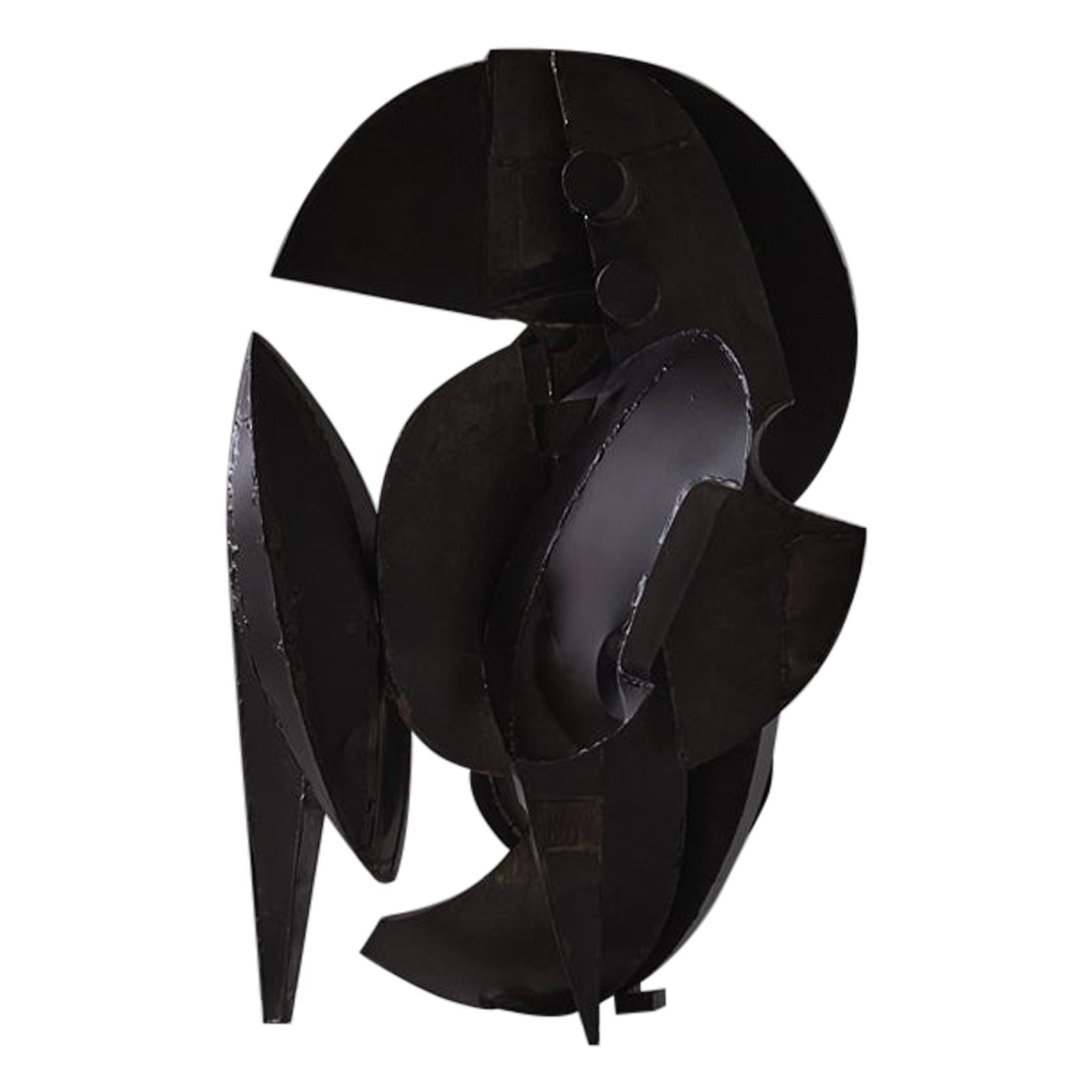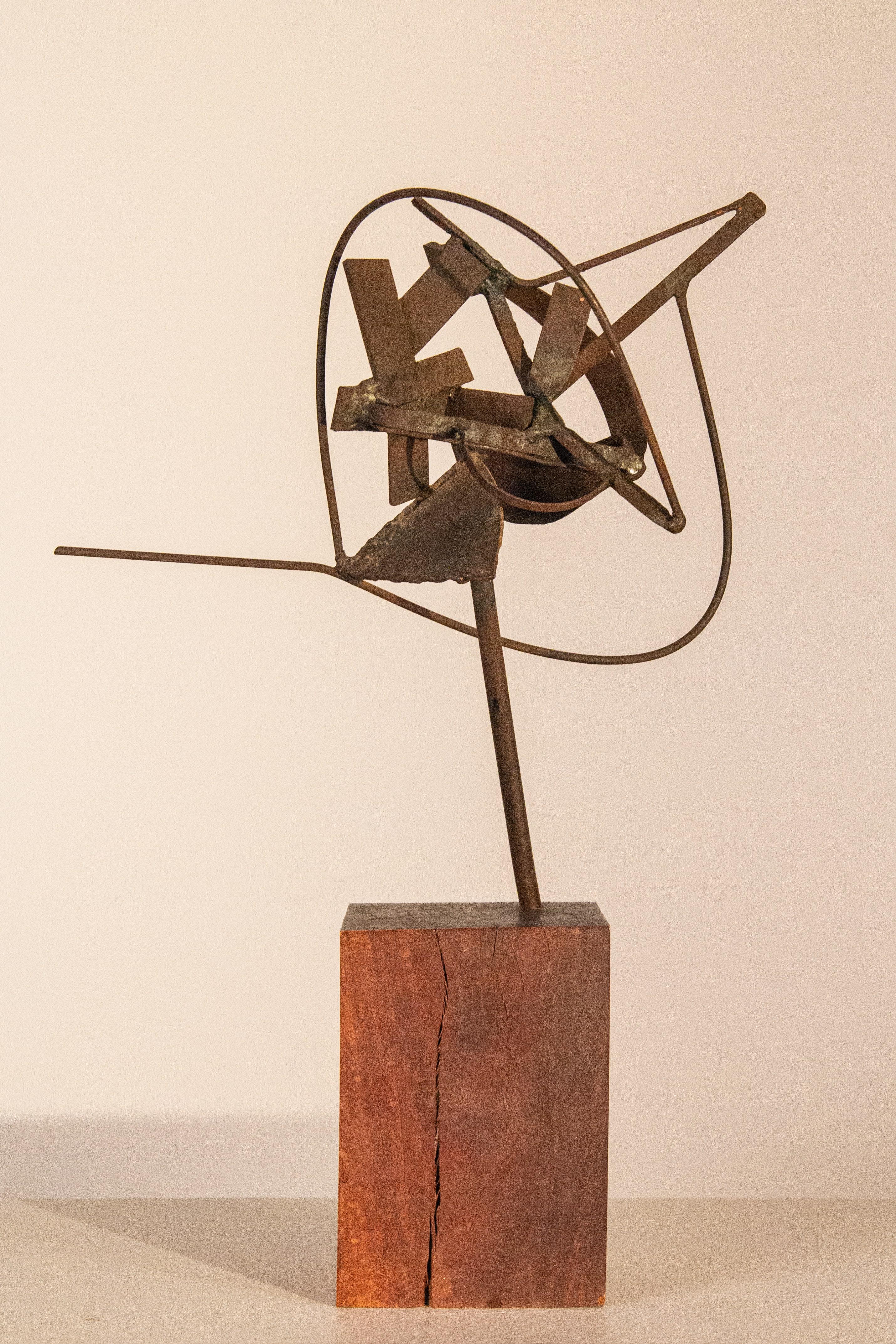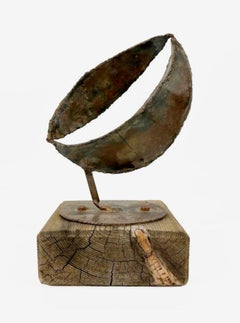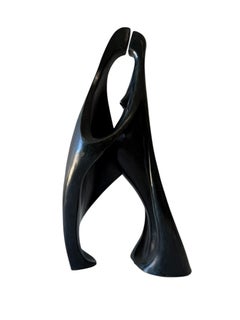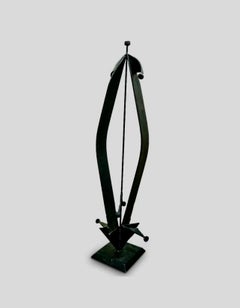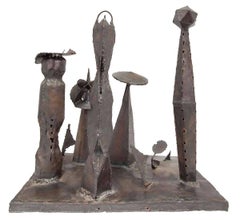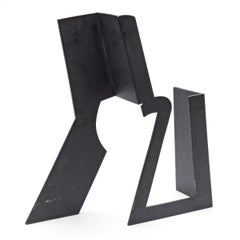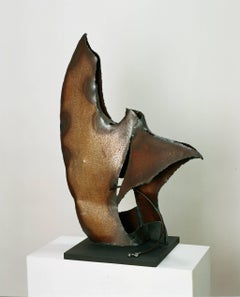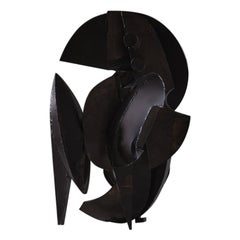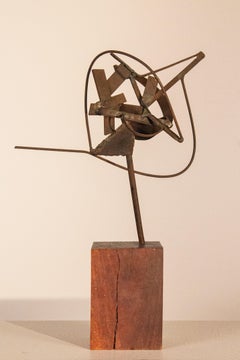Items Similar to 1982 Argentine Metal Sculpture "Serie De Los Sobres" Maria Simon
Want more images or videos?
Request additional images or videos from the seller
1 of 9
María Simón1982 Argentine Metal Sculpture "Serie De Los Sobres" Maria Simon1982
1982
$8,500
£6,445.54
€7,457.79
CA$12,015.06
A$13,394.48
CHF 6,985.77
MX$161,970.34
NOK 87,814.60
SEK 83,090.16
DKK 55,664.76
About the Item
María Simón
Argentinian (1922-2009)
Untitled (from Serie de los Sobres)
1982
welded and enameled black sheetmetal sculpture
Escultura en metal, moldeado, soldado, esmaltado
18 1/4 x 11 1/4 x 8 1/2 inches
Provenance:
The Graciela Kartofel Collection
María Simón Padrós (1922 – 5 July 2009) was an Argentine sculptor.
Simón was born in Aguilares, Tucumán in 1922. Her father, John Simon Padrós, was an engineer, a prominent politician and industrialist; her mother was Emilia Dublé. Today she is represented in the collections of the Museo Moderno and the Museo de Bellas Artes, where one of her sculptures is on display until the end of July, along with others by Noemí Gerstein and Juana Heras Velasco. At the age of 20, Simón studied sculpture with Jean Labourdette and five years later, with Libero Badíi. In 1964, she obtained a grant awarded by the British Council and moved to London, where she exhibited at the Institute of Contemporary Arts (ICA). Two years later, she received the Georges Braque Prize, and decided to move to Paris, where she remained for thirty-five years. There, she participated in various exhibitions at the Galería Rioboo, Salones de Mayo, Réalités Nouvelles, and the Museo de Bellas Artes.
“The successful Groupe de Recherche d'Art Visuel, with Vasarely and Julio Le Parc –recalls Petrushansky in the catalogue-, was inaugurated at that time at the Denise Rene Gallery, a reference point for the artistic trend of the new op art and kinetic art in the 60s; long talks and discussions about the future of art created the new Parisian bohemian culture that took hold of the young beatniks and their confrontations with the existentialism of Albert Camus. The Argentines had a presence and founding ideas, forming a noisy front of innovations. In 1970 she married Jacques Lassaigne , who was appointed director of the Museum of Modern Art in Paris that same year. One of the photos included in the book shows her three years later in a bar, embraced by Julio Le Parc and two glasses of wine. They had reason to toast: that evening, Maria had opened two exhibitions simultaneously. One at the Galerie de Varenne, where she presented engravings, drawings, tapestry works and sculpture in bronze and aluminium, and another with her sculptures in black sheet metal at the aforementioned Denise René gallery. “She was a friend of all the artists of the time,” says Pellegrini. This is confirmed by other photos showing her with Luis Tomasello, Francis Bacon, Alicia Penalba – with whom she is said to have had a certain rivalry – Marc Chagall, Sonia Delaunay and the sculptor César Baldaccini. She also participated in the Venice Biennale (1972), Biennale of Tapestry in Lausanne, Biennials of Engraving at Ljubljana and in Puerto Rico, the First International Sculpture Street Exhibition in Santa Cruz de Tenerife, and the Basel Fail. In 1975, she won the Second Prize in Sculpture at the Biennial of São Paulo, and the First Prize at the Biennale Gravure Gibet in France. In 1981, she was awarded the Bronze Medal by the European Academy of Fine Arts.
Simón worked predominantly in bronze, fas well as iron and aluminum. She used lead, resin, acrylic, textiles, cardboard or wood in her works. In Paris, she experimented with cardboard boxes collected from the street. The box becomes a symbol of the human being discarded after use. Simón moved to Buenos Aires in 2001, where she lived and worked until her death in 2009. She had a recent show Maria Simon: Juego De Cajas
at Galeria Vasari.
Graciela Kartofel was an influential art historian, graduate of the Liberal Arts College at the University of Buenos Aires, Argentina in 1976. She created the Latin American Modern and Contemporary Art History Program for UNAM -Mexican National Autonomous University, Mexico City, where she was part of the Faculty for more than a decade before coming to New York. She is lecturer and visiting professor in different universities, among them Cristobal Colón University, Veracruz, Mex.; Universidad Michoacana, Morelia, Michoacán, the Hochschule für Künstlerische und Industrielle Gestaltung in Linz, Austria; and Hunter College, New York City. She works as critic and independent curator specializing in Contemporary Art, and Latin American Art.Even during a time when the art market largely ignored and marginalized Latin American artists and woman artists, Dr. Kartofel championed them. Not only did she give her academic attention to young emerging artists in particular, but she also made their work a part of her personal collection.
Marysole Wörner Baz, Mathias Goeritz, Pedro Friedeberg, Pál Kepenyes Naomi Siegmann, Jose Luis Cuevas, Juan Carlos Lasser , Rodolfo Morales and many more.
- Creator:María Simón (1922 - 2009, Argentinian)
- Creation Year:1982
- Dimensions:Height: 18.25 in (46.36 cm)Width: 11.25 in (28.58 cm)Depth: 8.5 in (21.59 cm)
- Medium:
- Movement & Style:
- Period:
- Condition:overall good condition, with some minor wear and scuffing, minor losses to enamel please refer to photos.
- Gallery Location:Surfside, FL
- Reference Number:1stDibs: LU38215219552
About the Seller
4.9
Platinum Seller
Premium sellers with a 4.7+ rating and 24-hour response times
Established in 1995
1stDibs seller since 2014
1,798 sales on 1stDibs
Typical response time: <1 hour
- ShippingRetrieving quote...Shipping from: Surfside, FL
- Return Policy
Authenticity Guarantee
In the unlikely event there’s an issue with an item’s authenticity, contact us within 1 year for a full refund. DetailsMoney-Back Guarantee
If your item is not as described, is damaged in transit, or does not arrive, contact us within 7 days for a full refund. Details24-Hour Cancellation
You have a 24-hour grace period in which to reconsider your purchase, with no questions asked.Vetted Professional Sellers
Our world-class sellers must adhere to strict standards for service and quality, maintaining the integrity of our listings.Price-Match Guarantee
If you find that a seller listed the same item for a lower price elsewhere, we’ll match it.Trusted Global Delivery
Our best-in-class carrier network provides specialized shipping options worldwide, including custom delivery.More From This Seller
View All1965 Canadian Israeli Art Brutalist Abstract Welded Steel Sculpture Eli Ilan
Located in Surfside, FL
Eli Ilan (אלי אילן), 1928-1982 was an Israeli sculptor.
Abstract organic pod shape. in either steel or iron mounted on a wooden plinth.
Ilan was born in Winnipeg, Manitoba. He enrolled in a premedical curriculum at the University of British Columbia in Vancouver and emigrated to Israel in 1948. He then studied prehistoric archaeology and physical anthropology at the Hebrew University of Jerusalem. In 1956, he returned to Canada to study sculpture at the Ontario College of Art & Design. He lived in Kibbutz Sasa from 1959 to 1963. He died in 1982 in Caesarea, Israel.
Education
1955 Hebrew University, Jerusalem, pre-historic archaeology and physical anthropology
1956 Ontario College of Art, Toronto, Canada, sculpture under Thomas Bowie
1959 Training College, Ottawa, criminal identification techniques
1969 Art Festival, Painting & Sculpture in Israel. Ganei Hataarucha, Tel Aviv
Artists: Chana Orloff, Eli Ilan, Zvi Aldouby, Jacob El Hanani, Ludwig Blum, Aharon Bezalel, Koki Doktori, Israel Hadany, Marcel Janco, Dov Feigin, Abel Pann, Esther Peretz Arad, Reuven Rubin, Ivan Schwebel, Jakob Steinhardt, Boris Schatz, Bezalel (Lilik) Schatz, Louise Schatz...
Category
1960s Abstract Abstract Sculptures
Materials
Stainless Steel
Latin American Art Figurative Abstract Bronze Sculpture Lovers Marcelo Morandin
Located in Surfside, FL
Marcelo Morandin 1933-1996
Untitled (Embracing Couple, Lovers)
Bronze 1988; ed. P/E; Hand signed, dated and editioned to lower edge DImensions: 48.5 x 32 x 21 cm / 18.8 x 12.5 x 8.2 inches (approximately)
PAREJA, Bronce, patinado
Marcelo Morandin (1933 - 1996) was active/lived in Argentina, Mexico.
Argentinian, Mexican Postwar & Contemporary sculptor Morandin is best known for his monumental sculpture. This is a wonderful, art deco inspired nude couple, the woman appears pregnant).
Marcello Morandín (Marcelo Román Morandín Paroni) was born in 1933 in Argentina. He was an important plastic artist and Argentine architect, distinguished in Mexico for being an excellent sculptor and furniture designer. At the end of his studies at the Faculty of Architecture of Buenos Aires, Argentina, he traveled to Mexico and settled in Xalapa, Veracruz. In this city he was part of several artistic projects and noted for being one of the founders of the Department of Aesthetic Research and Applied Design at the University of Veracruz, as well as the Department of Aesthetic Research at UNAM. Between the years 80 and 90, he carried out several monumental works, among them "La pigeon de la paz" a project for the UN; "The foundation of Tenochtitlan" located in front of the Official Residence of Los Pinos; and "The Kinetic Tower" Of the government of Veracruz that combines the light and the sound with diverse moving parts to the compass of the music of Arnold Schoenberg. (Lily Kassner. Dictionary of Mexican sculptors of the twentieth century. Volume II. Mexico. Conaculta, 1997). Similar in style to Israeli artists Aharon Bezalel and Isaac Kahn.
He has shown with Jose Villalobos, Nicolas Moreno, Pedro...
Category
1980s Abstract Sculptures
Materials
Bronze
Large Mario Almaguer Cuban Art Welded Painted Steel Abstract Sculpture Modernism
Located in Surfside, FL
Mario Almaguer (b. Marianao, Cuba, 1955) He moved to the U.S. in 1994 to Miami where since has been living and working. Essentially self-taught, he embraced sculpture as his mean for expression. Without any kind of formal academic education or training in the arts, perseverance and praxis made him an artist. His work has been influenced by cuban master Agustin Cardenas and british Henry Moore. In his early years until 1994 he produced a large amount of small and medium scale wooden sculptures. From 1994 to the present, Almaguer creates and produces steel sculptures. It's with his works on steel where he encounters a strong expression with a striking liberty hard to deliver in wood. His monumental sculptures were recently exhibited at Miami Dade...
Category
21st Century and Contemporary Abstract Abstract Sculptures
Materials
Steel
Mid Century Modern Brutalist Welded Expressionist Sculpture After Paul Evans
Located in Surfside, FL
In this bronze sculpture the artist (unknown) has welded together a group of totems or monuments into a unified piece. T
Neo-Dada Abstract Sculpture: Assemblages
In contrast, abstra...
Category
Mid-20th Century Abstract Expressionist Abstract Sculptures
Materials
Metal
Large Latin American Modernist Bronze Abstract Cuban Master Roberto Estopinan
By Roberto Estopiñan
Located in Surfside, FL
Roberto Estopinan, Cuban, 1920 - 2015
Dimensions: 24.5" wide x 13" high plus 6" high base.
Roberto Estopiñán (1921–2015) was a Cuban American sculptor known for his sculptures of the human form, including political prisoners. Born in Camaguey, Cuba, he lived in the United States for over fifty years. His works are held by major institutions such as the Museum of Modern Art, the Whitney Museum and the Smithsonian Museum of American Art.
Roberto Gabriel Estopinan, a sculptor, draftsman, and printmaker, was born in Havana, Cuba on March 18, 1921. Estopiñán enrolled at the San Alejandro Academy when he was just 14 years old and became the protegé and studio assistant of the sculptor Juan José Sicre. After graduation he traveled first to Mexico, where he met and befriended Francisco Zuniga, and studied Pre-Columbian sculpture. In 1949 he traveled to Europe, visiting England, France and Italy. In these trips he encountered the sculpture of Henry Moore and Marino Marini, and their humanistic yet formal visions would be influential on Estopinan's work. Estopiñán was a pioneer of direct carvings using wood and of welding techniques in Latin America. Throughout the 1950s, Estopiñán received important prizes at various national exhibitions in Havana. In 1953 he was the only semi-finalist from Latin America at the Tate Gallery's international sculpture competition for a Monument to the Unknown Political Prisoner. In 1961, the artist moved to New York, where he resided until 2002.
Roberto Gabriel Estopiñán a Cuban emigre sculptor who emigrated to exile in the United States not long after Fidel Castro’s revolution in 1959, is considered one of Latin America’s most important 20th-century artists. His work, which includes drawings and prints as well as sculptures in wood and bronze, is in the collections of New York’s Museum of Modern Art, the Smithsonian’s American Art Museum, the Art Institute of Chicago, and the Detroit Institute of Art, among many locations. He is best known for his stark, disturbing renderings of political prisoners, the fruit of his own experiences as a dissident under both Castro and his predecessor, the dictator Fulgencio Batista, and for his representations of the female torso that can remind viewers of both classical statuary and the high-modern, abstractly elongated work of Henry Moore.mHe was born in Havana to a father from Asturias in northwest Spain and a mother of African descent. Estopiñán was something of a prodigy. At the age of fourteen, he won the first prize in drawing at the Centro Asturiano, a regional association for Cubans of Asturian descent. Shortly afterward he received special permission to enter the San Alejandro Academy of Fine Arts in Havana. At the school he was mentored first by its director, the painter Armando Menocal (1863-1941), then by the landscape artist Antonio Rodríguez Morey (1872-1967), and finally by Juan José Sicre (1898-1974), regarded as one of Cuba’s greatest sculptors. Sicre, a professor of sculpture at the Academy, had helped introduce European modernist art to Cuba, and from the 1930s through the 1950s had sculpted monumental figures in Havana of José Martí and other Cuban national heroes that stand to this day. Estopiñán was first Sicre’s student, then his assistant, and, finally, his colleague for the next fifty years. After graduating from San Alejandro in 1942, Estopiñán began simultaneously teaching art at the Ceiba del Agua School for young men, assisting Sicre in public art projects and developing his own artistic vision. He also traveled widely, to Mexico, New York, France, and Italy. From the late 1940s through the 1950s his sculpture evolved from an early neoclassical phase under the influence of Maillol to what he defined as “formalist humanism”: emphasizing the abstract beauty of the shapes he sculpted while not abandoning the human figure as the basis of his work. As the 1950s progressed he chose to carve in native Cuban woods...
Category
20th Century Abstract Figurative Sculptures
Materials
Bronze
Scottish Abstract Contemporary Minimalist Art Bronze Sculpture Alan Johnston 2/2
Located in Surfside, FL
Alan Johnston (Scottish, born 1945),
Untitled, 1988, cast bronze, edition of 2, cast #2
Incised A.J. 2/2 88 on underside
Provenance: Jack Tilton Galler...
Category
1980s Abstract Sculptures
Materials
Bronze
You May Also Like
"Roland, " George Sugarman, Abstract Steel Sculpture
By George Sugarman
Located in New York, NY
George Sugarman (1912 - 1999)
Roland, 1970
Patinated steel
17 3/8 x 16 x 5 1/4 inches
Incised with the artist's signature and numbered "15/17" on the underside
Manufactured by Lippin...
Category
1970s Abstract Abstract Sculptures
Materials
Steel
F. Soriano Man Torso "Fugues"original steel unic piece abstract sculpture
By Ferran Soriano
Located in CORAL GABLES - MIAMI, FL
"Fugues"original steel unic piece abstract sculpture
Sculpture by the Spanish artist FERRAN SORIANO
Artist well known for his large format works on the street.
Iron and Steel
Ferr...
Category
21st Century and Contemporary Contemporary Figurative Sculptures
Materials
Steel
Abstract constructivist sculpture in metal by Sergio Ponzio IV, Italy 1971
Located in Rotterdam, ZH
Abstract constructivist sculpture in metal by Sergio Ponzio IV, Italy 1971. The sculpture is composed of bent and modelled patinated zinc sheets soldered together to create a sculptu...
Category
Vintage 1970s Italian Mid-Century Modern Abstract Sculptures
Materials
Metal, Zinc
"Untitled" Sidney Gordin, Abstract Metal Steel Sculpture
By Sidney Gordin
Located in New York, NY
Sidney Gordin
Untitled, 1958
Incised with initials
Welded Steel
15 x 10 1/2 x 6 inches
Provenance:
Eric Firestone Gallery, New York
On October 24, 1918, Sidney Gordin was born in Chelyabinsk, Russia. He spent his early years in Shanghai, China. At the age of four, he moved with his family to New York. Gordin’s nephew, Eliot Nemzer recalls that when Gordin was a child he attended “a dinner party with his parents. Someone showed him a book of pictures that when thumbed through quickly made the image appear to move. This person then gave him a wad of blank papers and something to write with. Sid created a similar type of moving image with his materials. All the adults at the party became quite excited [and] praised his efforts. Sid told me he thought this was a pivotal experience in guiding him towards his vocation.” During his formative years at Brooklyn Technical High School, he briefly contemplated the idea of becoming an architect; yet, by the time he enrolled at Cooper Union, he was determined to become a professional artist. There, he studied under Morris Kantor (1896-1974) and Leo Katz...
Category
1950s Abstract Abstract Sculptures
Materials
Steel
$11,200 Sale Price
20% Off
1980 Italy Abstract Bronze Sculpture by Ottorino Tonelli Giulietta Juliet
Located in Brescia, IT
This artwork was created by the Italian artist Ottorino Tonelli.
Ottorino Tonelli was born in 1948 in Carrara, where he lives and works. After having completed his studies at the Flo...
Category
Late 20th Century Post-Modern Abstract Sculptures
Materials
Bronze
1980 Italy Bronze Abstract Sculpture by Ottorino Tonelli Romeo
Located in Brescia, IT
This artwork was created by the Italian artist Ottorino Tonelli. Title "Romeo" .
Ottorino Tonelli was born in 1948 in Carrara, where he lives and works. After having completed his st...
Category
Late 20th Century Post-Modern Abstract Sculptures
Materials
Bronze
More Ways To Browse
Metal Sheet Sculpture
Argentina Sculpture
Mexican Metal Sculpture
Kinetic Wood Sculpture
Argentina Textiles
Carlos Albert
Cesar Baldaccini
Vasarely Tapestry
Mario Jason Bronze
Mark Pharis
Mary Snowden
Mexican Clay Nativity
Michael Naranjo
Mighty Jaxx
Miguel Guia Sculpture
Monkey Stool
Monumental Chrome Hearts
Nates Gems
